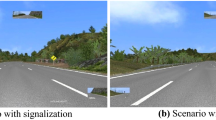Abstract
Recently, diffusion of telematics services and an explosive increase of in-vehicle display devices, such as Car Navigation Systems (CNSs), are becoming the new causes of traffic accidents. This is due to ‘inattention’ caused by an increase in the driver’s mental workload while he/she is driving. This situation has lead many countries to consider controlling the use of in-vehicle devices while driving through legislation. This research studies the effect of voice or display information systems on drivers through the Driver Eye Movement Analysis and the measurement of response ability. The experiment is carried out in a driving simulator and the results are presented through the comparative analysis of the driver’s visual field via the gaze tracking device and the average of correct answer rates for arithmetic problems.
Similar content being viewed by others
References
Cho, K. Y., Bae, C. H., Chu, Y. and Suh, M. W., “An Overview of Telematics: a System Architecture Approach,” Int. J. Automotive Technology, Vol. 7, No. 4, pp. 509–517, 2006.
Kim, H. K. and Lee, S. Y., “Trend of Telematics Technology,” J. Korea Institute of Communication Science, Vol. 20, No. 12, pp. 14–31, 2003.
Ross, T. and Burnett, G., “Evaluating the Human-Machine Interface to Vehicle Navigation Systems as an Example of Ubiquitous Computing,” Int. J. Human-Computer Studies, Vol. 55, No. 4, pp. 661–674, 2001.
Road Traffic Safety Authority (South Korea), “Statistical Analysis of Traffic Accident,” RTSA Annual Report, pp. 61–70, 2005.
Lal, S. K. and Craig, A., “A critical review of the psychophysiology of driver fatigue,” Biol. Psychol., Vol. 55, No. 3, pp. 173–194, 2001.
Choi, I. K., “A Study on the Analysis of Interface Design on Car Navigation System,” Proc. Conference of Korea Multimedia, pp. 361–367, 2002.
Wang, Y., Zhang, W., Wu, S. and Guo, Y., “Simulator for Driving Safety Study — A Literature Review,” Virtual Reality, Vol. 4563, pp. 584–593, 2007.
Suh, M. W., Koo, T. Y., Kwon, S. J., Shin, Y. S., Cho, K. Y. and Park, D. Y., “Development of SVPG,” Trans. Korean Society of Automotive Engineer, Vol. 10, No. 1, pp. 195–200, 2002.
Park, P. and Cha, D. W., “Development of Human-Machine Interface Evaluation System and Simulator for Car Navigation System,” Proc. ESK Conference, pp. 13–18, 1998.
Nobuyuki, U., Yoichi, A. and Kenshiro, P., “Effects of Cell Phone Conversation Load on Viewpoints Control while Driving,” JARI Research Journal, Vol. 24, No. 6, pp. 229–232, 2002.
Yuji, U., Shinichi, U. K., Takero, H., Ryuta, T. and Toshihiro, W., “Voice Information System that Adapts to Driver’s Mental Workload,” R&D Review of Toyota CRDL, Vol. 39, No. 1, pp. 16–22, 2004.
Young, K., Regan, M. and Hammer, M., “Driver Distraction: A Review of the Literature,” Monash University, Accident Research Centre, Report No. 206, pp. 44–52, 2003.
Stanton, N. A., Salmon, P. M., Walker, G. H., Baber, C. and Jenkins, D. P., “Human Factors Methods: A Practical Guide for Engineering and Design,” Ashgate Publishing Limited, pp. 301–305, 2005.
Angell, L., Auflick, J., Austria, P. A., Kochhar, D., Tijerina, L., Biever, W., Diptiman, T., Hogsett, J. and Kiger, S., “Driver Workload Metrics Project Task2 Final Report,” DOT Technical Report, No. DOT HS 810 635, pp. 427–433, 2006.
Jin, H., Katusuura, T., Iwanaga, K., Shimomura, Y., Sugiura, K. and Mochizuki, M., “Evaluation of mental workload accompanying the cognitive task of in- vehicle information device,” Proc. 6th Asian Design International Conference, 2003.
Takada, Y. and Shimoyama, O., “Evaluation of drivingassistance system based on drivers’ workload,” Proc. Int. Driving Symposium on Human Factors in Driver Assessment, Training and Vehicle Design, 2001.
Uno, H. and Hiramatsu, K., “Effect of auditory distractions on driving behavior during lane change course negotiation: estimation of spare mental capacity as a index of attention distraction,” JSAE Review, Vol. 21, No. 2, pp. 219–224, 2000.
Author information
Authors and Affiliations
Corresponding author
Rights and permissions
About this article
Cite this article
Koo, TY., Park, KJ., Kim, BY. et al. A study on driver’s workload of telematics using a driving simulator: A comparison among information modalities. Int. J. Precis. Eng. Manuf. 10, 59–63 (2009). https://doi.org/10.1007/s12541-009-0048-6
Received:
Accepted:
Published:
Issue Date:
DOI: https://doi.org/10.1007/s12541-009-0048-6




